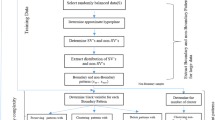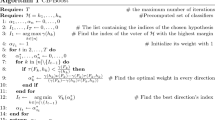Abstract
The paper presents a new condensation algorithm based on the idea of a sample representativeness. For each sample in a dataset a representative measure is counted. Starting with samples with the highest value of the measure, each sample and all its voters (which constitute single-class area) are condensed in one averaged prototype-sample. The algorithm is tested on nine well-known datasets and compared with Jozwik’s condensation methods.
Access this chapter
Tax calculation will be finalised at checkout
Purchases are for personal use only
Preview
Unable to display preview. Download preview PDF.
Similar content being viewed by others
References
Bezdek, J.C., Reichherzer, T.R., Lim, G.S., Attikiouzel, Y.: Multiple-prototype classifier design. IEEE Transactions on Systems, Man, and Cybernetics, Part C: Applications and Reviews 28(1), 67–79 (1998)
Chang, C.L.: Finding prototypes for nearest neighbor classifiers. IEEE Transactions on Computers C-23(11), 1179–1184 (1974)
Chen, C.H., Jozwik, A.: A sample set condensation algorithm for the class sensitive artificial neural network. Pattern Recognition Letters 17(8), 819–823 (1996)
Duda, R.O., Hart, P.E., Stork, D.G.: Pattern Classification, 2nd edn. John Wiley & Sons, Inc., Chichester (2001)
Frank, A., Asuncion, A.: UCI Machine Learning Repository. University of California, School of Information and Computer Science, Irvine, CA (2010), http://archive.ics.uci.edu/ml
Jozwik, A., Kies, P.: Reference set size reduction for 1-NN rule based on finding mutually nearest and mutually furthest pairs of points. Computer Recognition Systems, Advances in Soft Computing 30, 195–202 (2005)
Mollineda, R.A., Ferri, F.J., Vidal, E.: An efficient prototype merging strategy for the condensed 1-NN rule through class-conditional hierarchical clustering. Pattern Recognition 35(12), 2771–2782 (2002)
Sanchez, J.S.: High training set size reduction by space partitioning and prototype abstraction. Pattern Recognition 37(7), 1561–1564 (2004)
The ELENA Project Real Databases, http://www.dice.ucl.ac.be/neural-nets/Research/Projects/ELENA/databases/REAL/
Theodoridis, S., Koutroumbas, K.: Pattern Recognition, 3rd edn. Academic Press - Elsevier, USA (2006)
Wilson, D.R., Martinez, T.R.: Reduction techniques for instance-based learning algorithms. Machine Learning 38(3), 257–286 (2000)
Author information
Authors and Affiliations
Editor information
Editors and Affiliations
Rights and permissions
Copyright information
© 2011 Springer-Verlag Berlin Heidelberg
About this paper
Cite this paper
Raniszewski, M. (2011). Prototype Extraction of a Single-Class Area for the Condensed 1-NN Rule. In: Burduk, R., Kurzyński, M., Woźniak, M., Żołnierek, A. (eds) Computer Recognition Systems 4. Advances in Intelligent and Soft Computing, vol 95. Springer, Berlin, Heidelberg. https://doi.org/10.1007/978-3-642-20320-6_13
Download citation
DOI: https://doi.org/10.1007/978-3-642-20320-6_13
Publisher Name: Springer, Berlin, Heidelberg
Print ISBN: 978-3-642-20319-0
Online ISBN: 978-3-642-20320-6
eBook Packages: EngineeringEngineering (R0)




